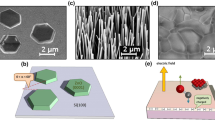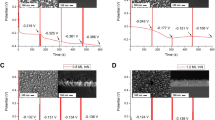Abstract
It was observed that silicon and germanium nanowires can exhibit significant electrostatic charging and respond strongly to externally applied electric fields. This includes nanowires in air and dispersed in low-conductivity, low-dielectric-constant solvents such as hexane, toluene, and benzene. The electrostatic charging of semiconductor nanowires was investigated as a tool for nanowire manipulation. By charging a substrate, nanowires could be deposited on surfaces with very high coverage and onto selected locations of the surface. The density of deposited nanowires could be adjusted systematically by varying the strength of the electric field. Alternating electric fields, applied between two electrodes, resulted in nanowires oriented with respect to the field orientation.








Similar content being viewed by others
References
T. Hanrath and B.A. Korgel: Nucleation and growth of germanium nanowires seeded by organic monolayer-coated gold nanocrystals. J. Am. Chem. Soc. 124, 1424 (2002).
T. Hanrath and B.A. Korgel: Supercritical fluid-liquid-solid (SFLS) synthesis of Si and Ge nanowires seeded by colloidal metal nanocrystals. Adv. Mater. 15, 437 (2003).
D.C. Lee, T. Hanrath, and B.A. Korgel: The role of precursor-decomposition kinetics in silicon-nanowire synthesis in organic solvents. Angew. Chem. Int. Ed. 44, 3573 (2005).
H.-Y. Tuan and B.A. Korgel: Importance of solvent-mediated phenylsilane decomposition kinetics for high-yield solution-phase silicon nanowire synthesis. Chem. Mater. 20, 1239 (2008).
T. Abbasi and S.A. Abbasi: Dust explosions–cases, causes, consequences, and control. J. Hazard. Mater. 140, 7 (2007).
N. Gibson and F.C. Lloyd: Electrification of toluene flowing in large-diameter metal pipes. J. Phys. D: Appl. Phys. 3, 563 (1970).
M. Glor: Hazards and problems associated with liquids. J. Electrost. 51, 359 (2001).
V.C. Holmberg and B.A. Korgel: Corrosion resistance of thiol- and alkene-passivated germanium nanowires. Chem. Mater. 22, 3698 (2010).
D.A. Smith, V.C. Holmberg, and B.A. Korgel: Flexible germanium nanowires: Ideal strength, room temperature plasticity, and bendable semiconductor fabric. ACS Nano 4, 2356 (2010).
J. Yuan, X. Liu, O. Akbulut, J. Hu, S.L. Suib, J. Kong, and F. Stellacci: Superwetting nanowire membranes for selective absorption. Nat. Nanotechnol. 3, 332 (2008).
V.C. Holmberg, M.R. Rasch, and B.A. Korgel: PEGylation of carboxylic acid-functionalized germanium nanowires. Langmuir 26, 14241 (2010).
Charged Ge Nanowire Fabric (mp4) is a video of the electrostatic charging phenomena shown in Fig. 2. It is available online at http://journals.cambridge.org/jmr.
Electrostatic Repulsion (mp4) is a video of Si nanowires in toluene moving in response to the static charge on a nitrile glove. It is available online at http://journals.cambridge.org/jmr.
D.K. Davies: Charge generation on dielectric surfaces. J. Phys. D: Appl. Phys. 2, 1533 (1969).
D.S. Pierce: Mechanics of Impression Evidence (CRC Press, London, England, 2011), p. 191.
V. Protasenko, S. Gordeyev, and M. Kuno: Spatial and intensity modulation of nanowire emission induced by mobile charges. J. Am. Chem. Soc. 129, 13160 (2007).
R. Zhou, H.C. Chang, V. Protasenko, M. Kuno, A.K. Singh, D. Jena, and H. Xing: CdSe nanowires with illumination-enhanced conductivity: Induced dipoles, dielectrophoretic assembly, and field-sensitive emission. J. Appl. Phys. 101, 073704 (2007).
Acknowledgment
This research was supported by the Robert A. Welch Foundation (F-1464) and the Air Force Research Laboratory (FA8650-07-2-5061). V.C. Holmberg acknowledges the Fannie and John Hertz Foundation and the NSF Graduate Research Fellowship Program for financial support.
Author information
Authors and Affiliations
Corresponding author
Rights and permissions
About this article
Cite this article
Holmberg, V.C., Patel, R.N. & Korgel, B.A. Electrostatic charging and manipulation of semiconductor nanowires. Journal of Materials Research 26, 2305–2310 (2011). https://doi.org/10.1557/jmr.2011.152
Received:
Accepted:
Published:
Issue Date:
DOI: https://doi.org/10.1557/jmr.2011.152




